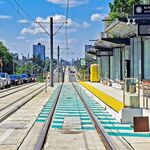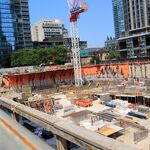Some resilient leafy trees would be better imho or protected bike lanes - may as well get some use (shade or active transportation) from those grassy shoulders/medians. Feels like flowers are neither here nor there (though still a welcome public realm improvement).
Thoughts:
1) It can be both. Obvoiusly if trees create a high degree of shade it changes which flowers you plant, but there are many native wildflowers than grow in shade.
There are also many boulevards that get southern or western sun exposure where there is more than enough sun to support a full range of wild flowers.
The object of the example is to move away from mowed grass which is largely unnecessary.+ costs money to mow, weed etc.
2) There are areas where trees or at least full-size trees precluded. See the Meadoway as an example with hydro corridors; but likewise think of those streets supporting streetcars which not only have wires, but said wires are very low slung.
You can plant 'full' trees underneath, but they will have to be aggressively pruned and that will impair their longer term prospects; and in the interim allow more sun at street level.
3) You can apply this lesson to other areas, parks, utility corridors, private lawns both corporate and personal, and highway corridors, where trees are not planted close to the road, both because they wouldn't do well; but also
to protect sight-lines.
4) We need some meadow habitats to support the full range of biodiversity. For the same reason, where we support road-side ditches, we should have naturalized swails that are mini-wetlands which can support some aquatic life, insects and a range of birds. (not appropriate everywhere, but perfect along some low-traffic rural highways/roads).





